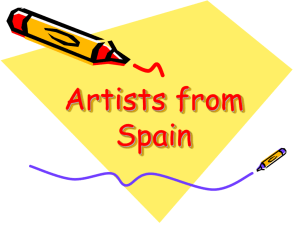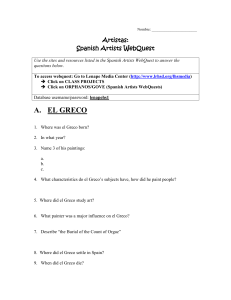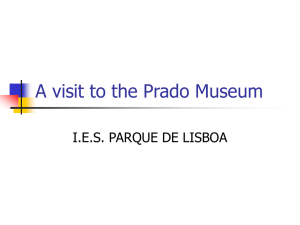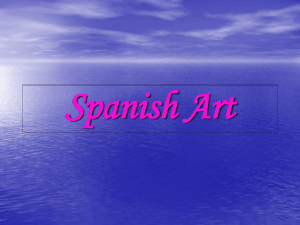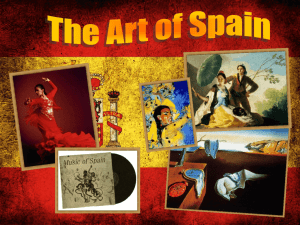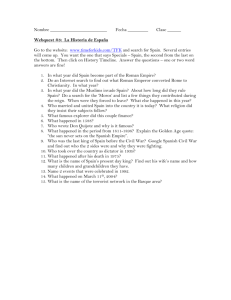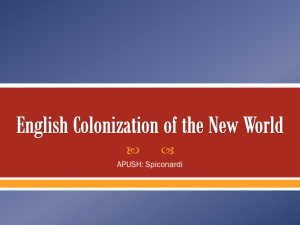Dr. Mercedes Juliá Department Chair
advertisement
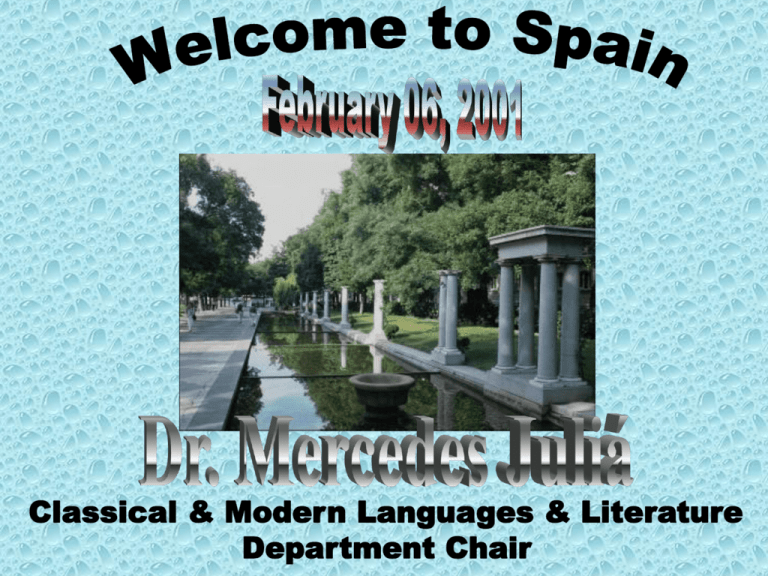
Classical & Modern Languages & Literature Department Chair Agenda Day 1 • History and Overview of Spain • Demographics • Spanish Art • Images of Spain’s Cities Day 2 • Spanish Civil War • Political System • Cultural Values Area 504,782 sq km Literacy 96% Population 39,418,000 Life expectancy 78 years Capital Madrid 2,866,900 GDP per capita $16,400 Religion Roman Catholic Economy Ind: textiles, apparel (including footwear), food, beverages. Agr: grain, vegetables; beef; fish. Exp: cars, trucks, semifinished manufactured goods, foodstuffs. Language Spanish, Catalan, Galician, Basque Spain’s Flag Spain’s Emblem The Regions of Spain An Overview of the History of Spain • • • • • • • • The First Settlers Phoenicians and Celts The Romans The Arabic Conquest The Reconquest Isabella and Ferdinand Christopher Columbus and America Spanish Kings and Queens La Cueva de Altamira La Dama de Elche Phoenicians El acueducto de Segovia Lucio Anneo Séneca A Romanic Church The cathedral of Santiago de compostela La Alhambra La Mezquita de Córdoba La Giralda La Catedral de León La Catedral de León Isabella and Ferdinand b. 1451, Madrigal de las Altas Torres, d. 1504, Medina del Campo, Spain b. 1452, Sos, Aragon d. 1516, Madrigalejo, Spain Arrival of Columbus in America Columbus, Christopher b. 1451, Genoa [Italy] d. 1506, Valladolid, Spain Spanish Art • • • • • El Greco Velázquez Goya Picasso Dalí El Greco b. 1541, Candia [Iráklion], Crete d. 1614, Toledo, Spain The Knight with His Hand on His Breast 1577 El Greco Burial of the Count de Orgaz 1586-88 View of Toledo 1597 El Greco Baptism of Christ 1597-1600 El Greco Portrait of a Cardinal 1600 ( El Greco Diego Velázquez (1599-1660) The Christ of Velázquez (1632) Las Meninas 1656 Velázquez The Weavers 1657 Velázquez Velázquez Velázquez The Naked Maja 1800-05 The Clothed Maja 1800-05 Goya Goya Goya did a collective portrait of the family of Charles IV, who had named him to the post of Court Painter, in the year 1800; in fact it was the last royal portrait he would paint. The Royal Family seems to be presided over by Queen Maria Luisa, as was the case in fact, instead of by the king. Goya included himself, by the way a self-portrait, before a canvas on the left of the painting, as Velázquez had done many years before when he painted the Family of Philip IV, called Las Meninas. Goya always recognized Velázquez, together with Rembrandt and Mother Nature, as his only three teachers. His technique. loose brush strokes that seem almost impressionistic, reached one of its highest levels in this painting. The Shootings of May Third 1808 1814 Goya’s Black Paintings During the latter part of his life, before he moved to France, where he died, Goya covered the walls of his Deaf Man's House with his famous "black paintings" the last and most weird and extrovert of his strange and haunted genius. Some of his visions seem to go deeper into the dark recesses of the mind than we are capable of penetrating. One, "Saturn Devouring one of his Children", is one of the most horrifying pictures ever painted. His life built up to a climax, isolations and despair provided the conditions in which he produced his innermost masterpieces. In many ways he personified the spirit of Spain, where the power and beauty of death seemed to brood in the air. Old Men Eating 1820-1823 Goya Saturn Devouring one of his Children 1821-23 Goya Pablo Picasso b. Oct. 25, 1881, Málaga, Spain d. April 8, 1973, Mougins, France Melancholy Woman 1902 Picasso The Old Guitarist 1903 Picasso Guernica 1937 Picasso Salvador Dalí b. May 11, 1904, Figueras, Spain d. Jan. 23, 1989, Figueras Dalí William Tell, circa 1930 Dalí The Persistence of Memory, circa 1931 Dalí Sleep, 1937 Dalí The Endless Enigma, circa 1938 http://www.concierge.com/run/concierge/PhotoGalleryDetail? • founded more than one thousand years ago • proclaimed official capital of the Kingdom of Spain in 1561, when Felipe II transferred the Court to this city. • Located in the center of the Iberian peninsula, Madrid has a pleasant year-round Continental climate. • Today, it is a city in which past and present live together, creating, in its diversity, a unique and attractive setting, with a population (more than 3 million inhabitants) that is characterized by its affability and hospitality • Coming from abroad, you can change your currency into pesetas in banks, at the airport and also in many change offices located in main streets. Spain’s Royal Family Health Care in Barcelona Gaudi Casa Milo 1905 to 1910 Gaudi Casa Milo 1905 to 1910 Gaudi Alicante Alicante ALICANTE is the southernmost of the three provinces which make up the Valencia region. Many tourist attractions can be found along the coastline, including sport of all kinds, mountains, castles, forests, etc. The central area of Alicante extends inland towards the industrial area with the towns of Elche, Aspe, Movelda and Elda. The southern area with the maritime towns of Guardamar, Torrevieja and Orihuela with extensive plains of market gardens which extend inland. The mountain area which includes the foothills of Aitana, Mariola and Carrasqueta Sierras. Especially important is the route of the castles, made up of the fortresses of Villena, Bañeres, Biar, Castalla, Sax and Benejama. The city of Alicante offers the visitor numerous beaches including San Juan, and also tourists should visit Santa Barbara Castle, Monastery of Santa Faz, the Cathedral, the Archaeeological Museum, Church of Santa Maria and the Modern Art Museum.
